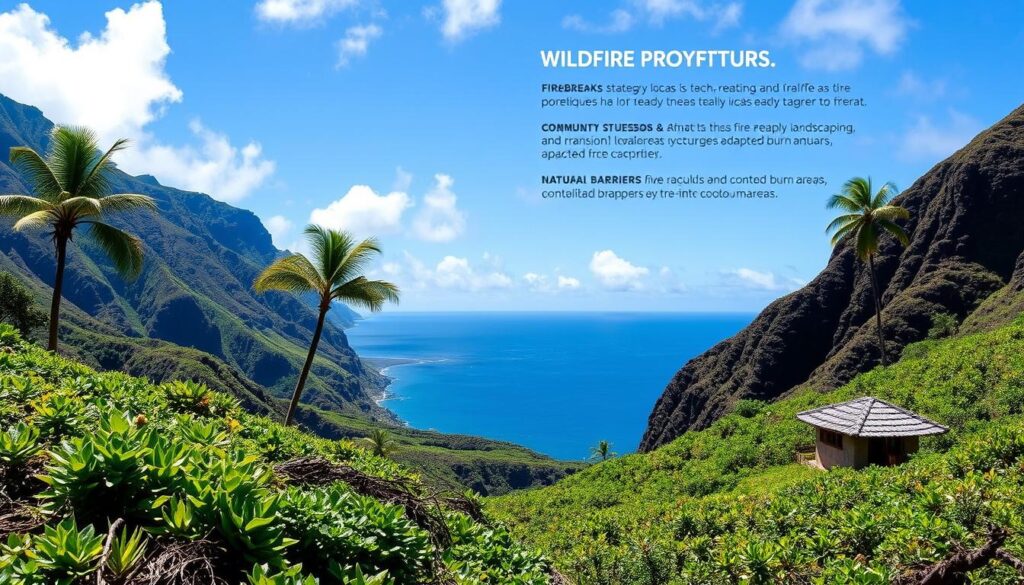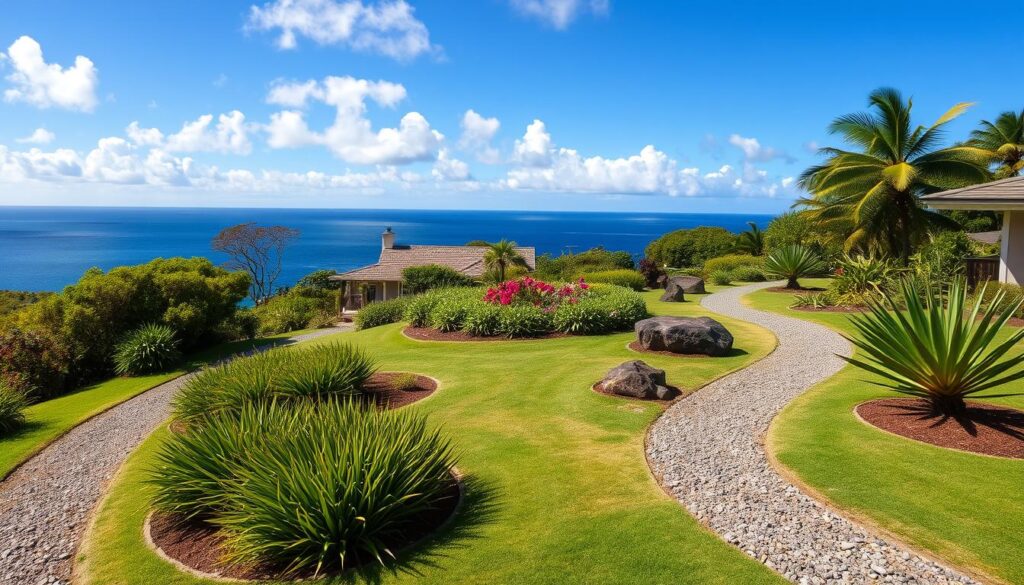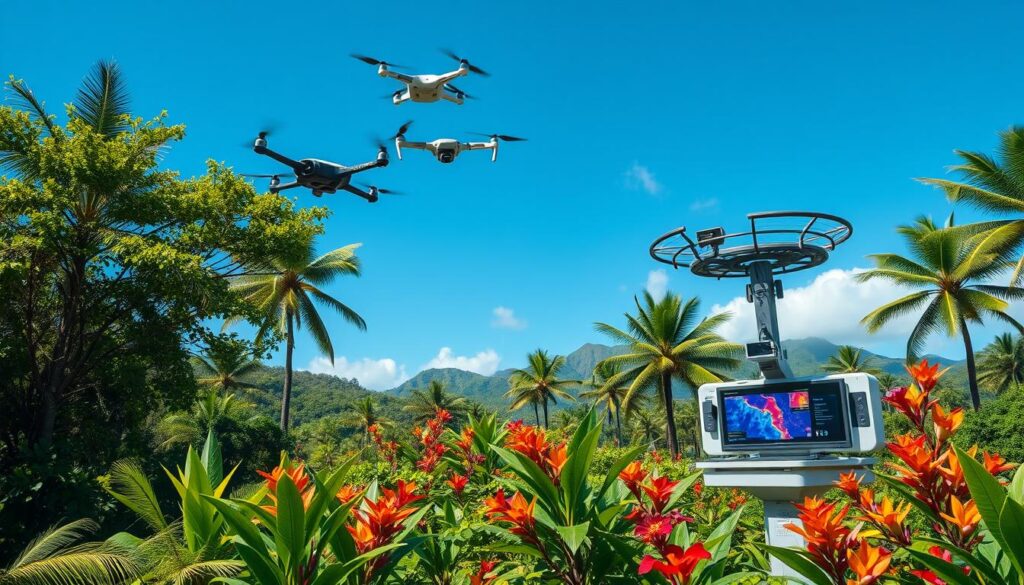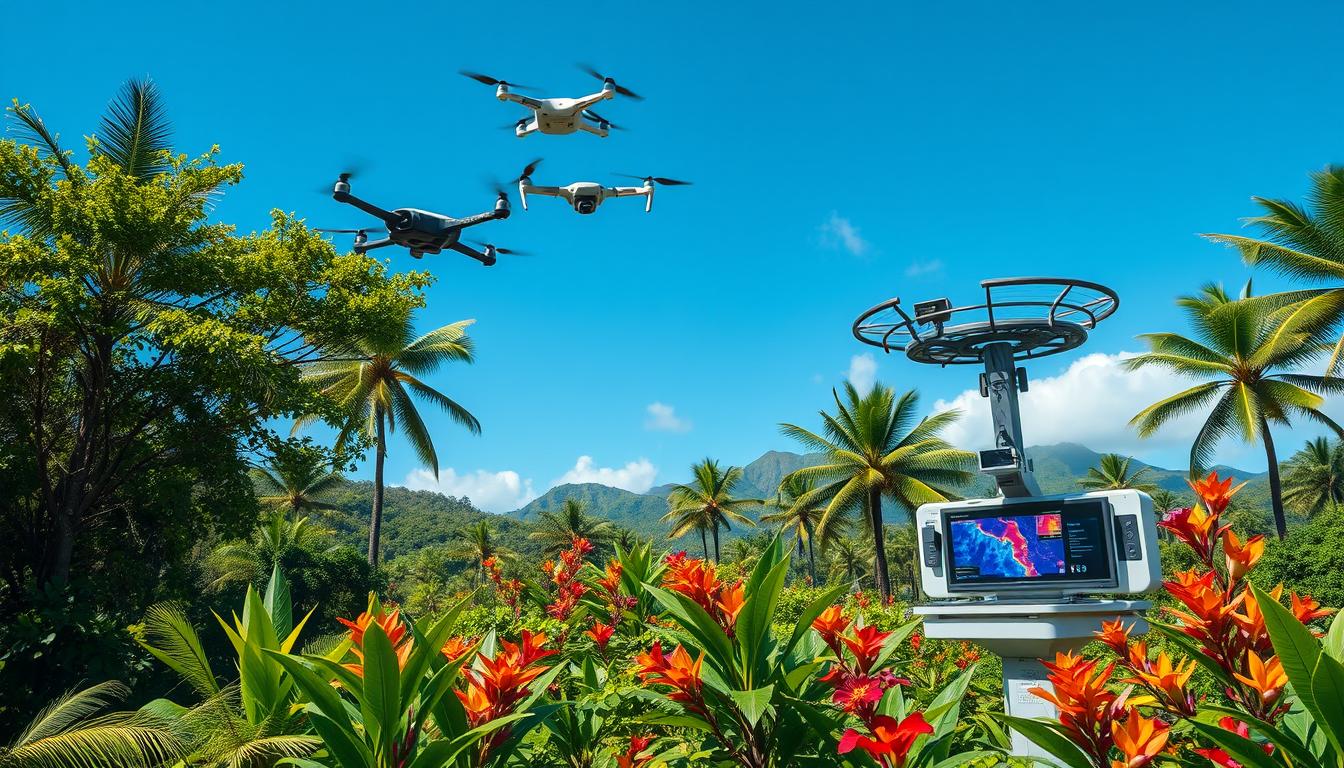In the stunning Hawaiian archipelago, the Hawaii Wildfire Management Organization (HWMO) is a beacon of hope. It works to protect the islands’ delicate ecosystems from wildfires. HWMO aims to address the unique fire risks that threaten Hawaii’s natural wonders and communities.
Hawaii’s diverse ecosystem is a testament to nature’s resilience. But, its rich biodiversity makes it vulnerable to uncontrolled fires. HWMO uses a multifaceted approach to prevent fires. This includes community education, strategic land management, and advanced monitoring systems.

Key Takeaways
- The Hawaii Wildfire Management Organization (HWMO) is dedicated to protecting the islands’ delicate ecosystems from the devastating impacts of wildfires.
- HWMO’s mission is to proactively address the unique fire risks that threaten Hawaii’s natural wonders and communities.
- HWMO employs a multifaceted approach to fire prevention, including community education, strategic land management, and advanced monitoring systems.
- The organization plays a vital role in safeguarding Hawaii’s diverse and resilient ecosystem from the dangers of uncontrolled fires.
- HWMO’s fire prevention efforts are crucial in preserving the natural beauty and environmental balance of the Hawaiian islands.
Understanding Fire Risks in Hawaii’s Unique Ecosystem
Hawaii’s lush, tropical landscape is home to a diverse and delicate Hawaiian ecosystem. But, this environment faces a growing threat from fire-prone vegetation and climate change. It’s important to understand the complex factors at play to mitigate these risks.
Native Hawaiian Vegetation and Fire Susceptibility
Many of Hawaii’s native plants, like the iconic koa and ohia trees, are well adapted to the tropical climate. Unfortunately, this makes them very vulnerable to fires. Introduced species like guinea grass and Christmas berry also add to the risk.
Climate Change Impact on Fire Hazards
The effects of climate change are already being felt in Hawaii. There’s been an increase in average temperatures, changes in rainfall patterns, and more frequent droughts. These changes create ideal conditions for fires, increasing the risk of wildfire outbreaks.
Seasonal Fire Risk Patterns
Hawaii sees different fire risks throughout the year. The summer months have a higher risk of wildfires. This is due to drier weather, more human activity, and the abundance of fire-prone vegetation.
| Season | Fire Risk Factors | Potential Impacts |
|---|---|---|
| Summer | Drier weather, increased human activity, abundant fire-prone vegetation | Higher risk of wildfires, potential damage to native ecosystems and property |
| Winter | Wetter weather, decreased human activity, less fire-prone vegetation growth | Lower risk of wildfires, but potential for increased invasive species growth |
Understanding Hawaii’s fire risks is key to developing effective prevention and response strategies. By tackling the challenges of fire-prone vegetation, climate change, and seasonal patterns, the Hawaii Wildfire Management Organization can protect the islands’ natural treasures and communities.
The Role of Hawaii Wildfire Management Organization
The Hawaii Wildfire Management Organization (HWMO) is key in fighting wildfires in Hawaii. It leads in fire prevention and management. The HWMO works hard to protect Hawaii’s special and delicate environment.
The HWMO focuses on working with the community. It teams up with locals, businesses, and government to teach about fire dangers. They run programs, workshops, and neighborhood watches to help people prevent wildfires.
- Conducting regular fire prevention workshops and training sessions for the public
- Implementing neighborhood-based programs to encourage fire-safe practices
- Partnering with state and federal agencies to coordinate emergency response protocols
- Utilizing advanced fire detection and monitoring systems to identify and address potential threats
The HWMO uses many strategies to help Hawaii’s communities fight wildfires. Their hard work and teamwork help keep the islands beautiful and safe for everyone.
“The HWMO’s efforts are critical in ensuring the long-term resilience of Hawaii’s communities and ecosystems in the face of growing wildfire threats.”
Community-Based Fire Prevention Strategies
The Hawaii Wildfire Management Organization is deeply committed to involving local communities in fire prevention. They use a variety of methods to help residents and build a culture of readiness across the Hawaiian islands.
Educational Programs and Workshops
The organization leads many community fire education efforts. They offer interactive fire prevention workshops on topics like fire-resistant landscaping and home hardening. These sessions teach people how to protect their homes and communities.
Neighborhood Watch Fire Programs
The Hawaii Wildfire Management Organization also started neighborhood fire watch programs. These programs unite local people to watch over their areas, spot fire dangers, and report any issues. This teamwork helps spot fires early and respond quickly.
Local Emergency Response Training
The organization also focuses on emergency response training for the community. They hold workshops and drills to teach people about emergency procedures and first aid. This training helps local communities play a key role in fire emergencies.
| Community-Based Fire Prevention Strategies | Key Objectives |
|---|---|
| Educational Programs and Workshops | Equip residents with knowledge and skills to protect their properties and communities |
| Neighborhood Watch Fire Programs | Foster community collaboration to identify and report fire risks |
| Local Emergency Response Training | Empower residents to participate in the emergency response network |
“By working together, we can create a more resilient and fire-safe Hawaii. Our community-based strategies are key to protecting the unique natural heritage of these islands.”
Creating Defensible Spaces Around Island Properties
Hawaii’s island setting makes it prone to fires, making it crucial to take steps to protect homes and businesses. Creating defensible spaces around these properties is a key strategy. These spaces are designed to lower the risk of fire damage.
To make a defensible space, using fire-resistant landscaping is essential. This means choosing plants that don’t catch fire easily and keeping them well-watered. It also means removing things that can catch fire from around buildings. This way, homeowners can greatly increase their property’s chances of surviving a fire.
Key Elements of a Defensible Space
- Maintain a clear, well-watered zone around the structure, free of dry vegetation and flammable materials
- Strategically place trees and shrubs to create breaks in the fuel load and prevent the spread of fire
- Choose fire-resistant, drought-tolerant, and low-growing plants for landscaping
- Regularly prune and maintain trees and shrubs to prevent them from becoming ladder fuels
- Remove dead leaves, branches, and other debris from the property to eliminate potential ignition sources
By using fire-resistant landscaping, property owners in Hawaii can make their spaces safer from wildfires. This is a key part of the Hawaii Wildfire Management Organization’s plan to prevent fires.

| Flammable Plants | Fire-Resistant Plants |
|---|---|
| Eucalyptus | Hibiscus |
| Pine trees | Fountain grass |
| Juniper | Ginger |
| Bamboo | Ti plant |
“By creating defensible spaces around our properties, we can significantly reduce the risk of wildfire damage and protect the unique beauty of our Hawaiian islands.”
Native Hawaiian Fire Management Practices
Hawaii’s unique island ecosystem has long been shaped by the traditional fire management practices of its indigenous people. These time-honored techniques, rooted in cultural land stewardship, offer valuable insights for modern wildfire prevention and management efforts.
Traditional Knowledge Integration
Native Hawaiians have a deep understanding of their local environment. This traditional ecological knowledge has been passed down through generations. By integrating these proven indigenous fire practices with contemporary approaches, land managers can develop more holistic and effective strategies to safeguard Hawaii’s fragile landscapes.
Cultural Approaches to Land Management
At the heart of traditional Hawaiian fire management lies a reverence for the land and a commitment to sustainable resource use. Cultural practices such as controlled burns, selective vegetation clearing, and the preservation of native plant species help to maintain the delicate balance of Hawaii’s unique ecosystems.
Modern Adaptations of Ancient Techniques
While the fundamental principles of traditional Hawaiian fire management remain relevant, the modern context requires adapting these practices to address emerging challenges. By blending ancient wisdom with innovative technologies and scientific research, land managers can devise tailored solutions that address the evolving threats of wildfire in Hawaii.
| Traditional Hawaiian Fire Management Practices | Modern Adaptations |
|---|---|
| Controlled Burns | Prescribed Burning Programs |
| Selective Vegetation Clearing | Fuel Reduction Initiatives |
| Preservation of Native Plant Species | Habitat Restoration and Invasive Species Management |
By embracing the traditional Hawaiian fire management practices and cultural land stewardship approaches, Hawaii’s land managers can build upon the indigenous fire practices of the past to develop comprehensive and sustainable solutions for the future.
Advanced Fire Detection and Monitoring Systems
The Hawaii Wildfire Management Organization leads in using top-notch fire detection technology and early warning systems. They protect the islands from wildfires. With advanced wildfire monitoring tools, they quickly spot and act on fire dangers. This helps prevent big fires.
They use high-definition cameras and infrared sensors all over the islands. These tools spot smoke or heat early. This alerts the team to act fast, stopping fires before they spread.
They also watch the weather and environment with satellite images and data. This helps them know when fire risks are high. They get ready and use special plans to keep safe areas safe.
| Technology | Description | Benefits |
|---|---|---|
| HD Cameras and Infrared Sensors | Network of high-definition cameras and infrared sensors strategically placed across the islands | Rapid detection of smoke and heat, enabling a swift response to potential fire hazards |
| Satellite Imagery and Weather Data | Continuous monitoring of weather patterns and environmental conditions to anticipate periods of increased fire risk | Proactive preparation and deployment of resources to prevent and mitigate wildfires |
The Hawaii Wildfire Management Organization uses the latest in fire detection technology, early warning systems, and wildfire monitoring. They stay ahead of fires, keeping the islands safe for people and nature.

Collaborative Efforts with State and Federal Agencies
The Hawaii Wildfire Management Organization knows how key teamwork is in fighting fires. We work closely with state and federal agencies. This way, we can use our combined skills and resources to better prevent and manage fires in Hawaii.
Inter-Agency Coordination
We team up with local, state, and federal groups. This includes the Hawaii Department of Land and Natural Resources, the U.S. Forest Service, and FEMA. Through meetings, training, and sharing info, we make sure we’re all on the same page when it comes to wildfires.
Resource Sharing Networks
- We’ve set up strong networks for sharing resources like people, tools, and money.
- This teamwork means we can quickly get the right help to fire scenes.
- Together, we can use our best firefighting teams, air support, and tech to fight fires.
Emergency Response Protocols
We’ve made detailed plans with our partners for emergency responses. These plans help us talk clearly, make quick decisions, and act fast during fires. This way, we can manage emergencies well together.
| Agency | Role in Fire Response | Key Responsibilities |
|---|---|---|
| Hawaii Wildfire Management Organization | Coordination and Resource Allocation | Help teams work together, manage resources, and lead emergency efforts. |
| Hawaii Department of Land and Natural Resources | Land Management and Fire Suppression | Take care of public lands, do controlled burns, and fight fires on the ground. |
| U.S. Forest Service | Technical Expertise and Aerial Support | Share special knowledge, help with air support, and help train and grow skills. |
| Federal Emergency Management Agency (FEMA) | Disaster Response and Recovery | Help with federal aid, manage disaster declarations, and support recovery after fires. |
By working together, the Hawaii Wildfire Management Organization can protect our islands from wildfires. This teamwork helps keep our communities safe and strong.
Conclusion
The Hawaii Wildfire Management Organization is a shining example of resilience and innovation. It tackles the growing fire risks across the Hawaiian Islands with a mix of community involvement, advanced technology, and traditional Hawaiian fire management. This approach has made a big difference in protecting the islands’ unique ecosystems and keeping residents safe.
The organization works hard to educate the public on fire prevention. It also teams up with state and federal agencies to tackle fire threats. By using native Hawaiian knowledge and modern fire detection systems, it can better anticipate and respond to fires. This ensures Hawaii’s natural landscapes stay resilient for the long term.
Looking ahead, the organization’s dedication to fire prevention and ecosystem protection will keep the Hawaiian Islands beautiful and safe. It will build on past successes and adapt to new challenges from climate change. The Hawaii Wildfire Management Organization is ready to lead in making the region more fire-resilient and sustainable.
FAQ
What is the mission of the Hawaii Wildfire Management Organization?
The Hawaii Wildfire Management Organization aims to protect the Hawaiian islands from wildfires. It focuses on preventing fires, educating communities, and managing fire risks in Hawaii’s unique environment.
How does Hawaii’s ecosystem contribute to fire risks?
Hawaii’s native plants and climate change increase wildfire risks. The organization watches these factors to plan effective prevention and response strategies.
What are the key initiatives of the Hawaii Wildfire Management Organization?
The organization works on many fire prevention efforts. It includes community education, neighborhood watches, emergency training, and advanced fire detection systems.
How does the Hawaii Wildfire Management Organization collaborate with other agencies?
It teams up with state and federal agencies for emergency responses. They share resources and work together to manage wildfires across Hawaii.
What are the benefits of the Hawaii Wildfire Management Organization’s community-based strategies?
The organization educates and empowers local communities through programs and workshops. This approach helps reduce wildfire risks and builds resilience.
How does the organization incorporate traditional Hawaiian fire management practices?
It values traditional Hawaiian knowledge and blends it with modern strategies. This mix of old wisdom and new techniques protects the islands more effectively.
What role do defensible spaces play in protecting island properties?
The organization teaches how to create safe spaces around properties. Using fire-resistant landscaping and maintenance can lower the risk of property damage from wildfires.
How does the Hawaii Wildfire Management Organization leverage advanced technology?
It uses the latest fire detection and monitoring systems. These technologies, along with community efforts and collaboration, help manage wildfires in Hawaii.
